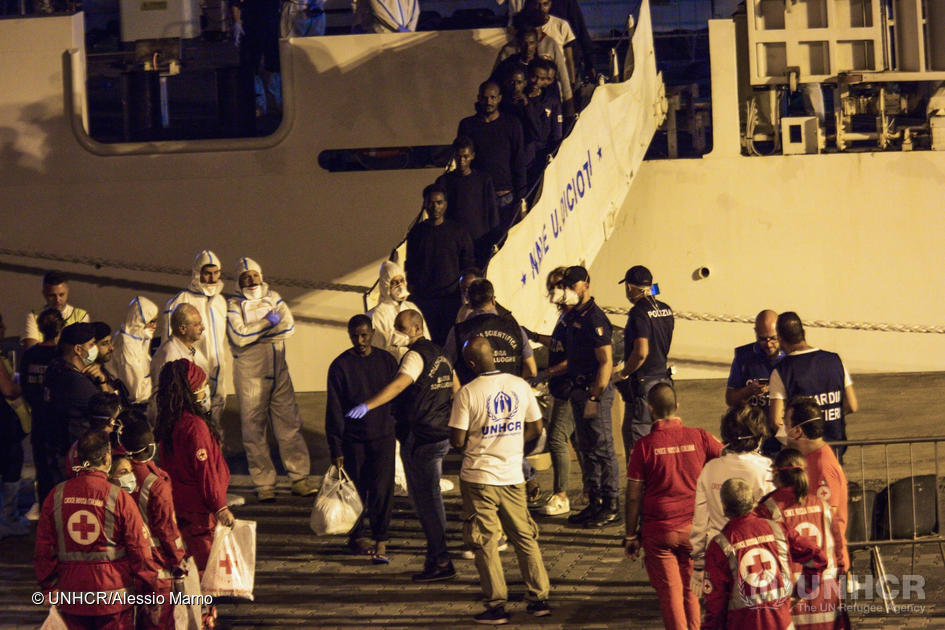Still no agreement on the proposed "regional disembarkation platforms" and "controlled centres"

On the 10th of June, the Aquarius – the boat chartered by the NGOs SOS Méditerranée and Médécins sans frontières – had just rescued 629 people at sea when Italy decided to close its ports and refuse the boat entry into their territory. The second country, Malta, also refused, rejecting any responsibility. The United Nations High Commissioner for Refugees (HCR) implored the governments involved to allow those on board the Aquarius to disembark and leave the question of responsibility for later. After a week of uncertainty, Spain volunteered a safe port for the humanitarian ship.
Confronted with this new challenge in the Mediterranean, and in advance of the European Council convening in June, the HCR and the International Organisation for Migration (IOM) proposed a far-sighted mechanism for people saved at sea to be taken to shore quickly and with dignity, while respecting the principle of non-refoulement.
The European Council convened on the 28th and 29th of June. Inspired by the proposal from the HCR and the IOM, they proposed the creation of “regional disembarkation platforms” outside the EU and “controlled centres” on EU territory. These “controlled centres” would be established on a voluntary basis, and would separate those eligible for asylum with economic migrants. Asylum seekers would be distributed among Member States (also on a voluntarily basis), while the others would be sent back to their countries of origin. One of the questions which still needs to be addressed is the difference between these centres and the hot-spot system created in 2015.
At the end of July, the European Commission said that the “disembarkation platforms” should be located “as far as possible from the points of departure for the migrants”. All Member States on the Mediterranean would have to establish search and rescue zones, working alongside maritime rescue coordination centres. Depending on where the search and rescue operations take place, it may be possible to take the migrants to a third-party country – provided that the principle of non-refoulement is respected. Alongside the HCR and the IOM, people in need of protection would be provided support and, eventually, placed in resettlement programmes. If they don’t need protection, they would be sent back to their country of origin, with the option to receive aid to return voluntarily and be reintegrated by the IOM.
As for the “controlled centres”, the European Commission proposes “total financial support” to volunteer member states, to cover the infrastructure and operational costs. The transfer costs would be 500 euros per person for the country which accepts the disembarking asylum seekers, and 6,000 euros per person would be allocated to the host country under the relocation programme. The Commission also proposes deploying border guards and European Agency control personnel in the centres to accelerate the treatment process for asylum seekers, relocations and expulsions.
Even before a formal EU proposition was issued, the Tunisian Ministry for Foreign Affairs ruled out the idea of “regional disembarkation platforms”, and was followed by his Moroccan and Algerian counterparts. The Moroccan Minister for Foreign Affairs called these measures “an easy way out”, paving the way for “counter-productive mechanisms”. This refusal was reiterated at the African Union summit on the 2nd of July.
The NGO Médecins sans frontières also denounced this proposal by the 28 states: “The only areas in which the European States seem to agree are, firstly, to hold people at the gates of Europe – no matter how vulnerable they are or from what horrors they are fleeing – and, secondly, to demonise non-governmental search and rescue operations.”. France terre d’asile supports the idea of a regional disembarkation mechanism to provide asylum, and remains committed to full solidarity between the countries in the Union – as long as they do not attempt to shift the responsibility to African countries.
The question of knowing where to process asylum applications seems to be at the heart of the debate. Austrian Chancellor Sebastian Kurz, who currently chairs the Presidency of the Council of the European Union, has stated that he is against the idea of giving migrants the option to seek asylum in the European Union from “regional disembarkation platforms”, fearing that this will only draw more migrants to Europe. The IOM, on the other hand, have said that the asylum seeker processing centres should be located in Europe, and not abroad. They consider that opening disembarkation platforms in Libya would be a major risk due to the current security situation.
On top of the disagreements about the “controlled centres”, there is no desire by States to have these structures on their territory and, as of today, no country has volunteered to host a permanent controlled centre. Emmanuel Macron has said that: “France will not open any centres” for migrants landing in Europe. He argues that France is “not a country of first arrival” and proposes to set them up in Italy, Spain and Greece, where migrants disembark, rather than have to transfer them throughout the EU. The informal Salzburg summit, hosted by Austria on the 19th and 20th of September, saw no progress on the matter due to “enduring differences“.
